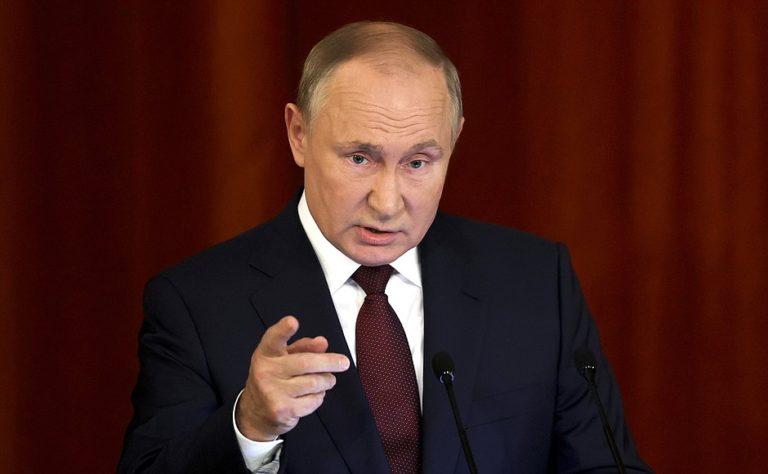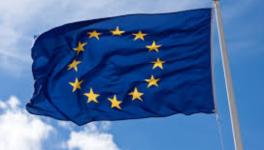Ukraine, Belarus in Eye of the Storm

President Vladimir Putin addressing the expanded meeting of the Russian Foreign Ministry Board, Moscow, November 18, 2021
Wouldn’t that be a delicious irony — the British defence secretary Ben Wallace rushing to Warsaw on Thursday to work up detailed plans to strengthen Poland’s border fence with Belarus? Britain had partnered the US in the invasion of Iraq in 2003 and is now the self-appointed protector of the European Union from Iraqi migrants!
As many as 150 British army Royal Engineers will be sent to help reinforce Poland’s border with Belarus. Wallace speculated that British troops might also help “potentially other Baltic states to secure their border.” The British media has reported quoting sources that hundreds of British special force troops and paratroopers are also ready to deploy to Ukraine amid rising tensions in that region.
On Tuesday, Wallace visited Kiev on what was billed as a show of support at a time when Ukraine and NATO countries have expressed concern about Russian troop movements near Ukraine’s borders.
A joint statement issued in Kiev following his talks Ukrainian Defence Minister Oleksii Reznikov stated amongst other things that stemming out of an Intergovernmental Framework Agreement signed in London last week between the two countries, joint projects will be undertaken to develop the capabilities of Ukraine’s naval forces in the Black Sea and for increasing interoperability.
Britain and Ukraine also recently finalised a treaty that will enable Kiev to seek loans from London to buy British warships and missiles. Sky News reported that “on Ukraine’s £1.7 billion shopping list are two mine hunters, the joint production of eight missile ships and a frigate as well as the purchase of weapons for existing vessels.”
Besides, Britain will build two naval bases for Ukraine in the Black Sea. Without doubt, Global Britain has seized the migrants issue and the war hysteria over Russia amassing troops on Ukraine’s borders to strengthen its strategic positioning in Central Europe and the Black Sea.
Traditionally, the UK acts in tandem with the US. In fact, on November 10, the US Secretary of State Antony J. Blinken and Ukrainian Foreign Minister Dmytro Kuleba signed a major document titled US-Ukraine Charter on Strategic Partnership in Washington, D.C. affirming Washington’s commitment that “Bolstering Ukraine’s ability to defend itself against threats to its territorial integrity and deepening Ukraine’s integration into Euro-Atlantic institutions (read NATO) are concurrent priorities.”
From beginning to end, the US-Ukrainian pact points finger at Russia directly or indirectly.
At any rate, in a statement last Saturday, the Russian Defence Ministry had alleged “military activity of an aggressive nature in the Black Sea region” by the US warships, U-2S strategic reconnaissance aircraft conducting surveillance mission along Russian border, a B-51 strategic bomber flying close to Russian border in the Black Sea, etc.
The big picture emerging out of all this is that an arc of encirclement of Russia is appearing from the Baltic region along Central Europe down to the Black Sea and the Caucasus. Unlike in the Cold War era, the NATO deployments come right up to Russia’s western and southern borders.
The Western capitals and Moscow have diametrically opposite interpretations of what is unfolding. The West’s interpretation is that Moscow is putting it to something of a stress test hoping that the migration crisis and the Russian force build-up on Ukraine’s border would expose divisions within the EU and NATO, which in turn would compel them to opt for pragmatic transactionalism by expediting the certification process of the Nord Stream gas pipeline (which the US, Ukraine and Poland are opposing.) .
In sum, the argument goes that the West should call Moscow’s bluff. On the other hand, Moscow’s narrative is that the Western powers are deliberately fuelling Ukraine’s revanchist instincts by arming it and encouraging the besieged leadership of President Zelensky in Kiev who is fighting for political survival to believe that with Western support, a window of opportunity is opening to recapture the lost territories in Donbas and the Crimea and thereby redeem his pledge to be his country’s saviour.
And, second, as Moscow sees it, the rising tensions with Russia have become a convenient alibi to directly involve the NATO in Ukraine’s security and make it a template of the West’s containment strategy against Russia.
Evidence is not lacking to buttress either interpretation. The US has been briefing the European allies that Moscow might create new facts on the ground and, therefore, counter-measures are needed. France has vowed to defend Ukraine if Russia attacks it. NATO has warned Russia, too.
In fact, Washington is going the extra league lately to bury the hatchet with Ankara too in a determined move to bring it back to the NATO fold. Turkey has close military ties with Ukraine, is a major Black Sea power and, above all, Ankara has a history of standing up to Moscow if push comes to shove.
Thus, on Tuesday, the US-Turkey High Level Defence Group convened at the Pentagon. Laura Cooper, Undersecretary of the US Defence Department, who led the American delegation, said that the military upgrade of Turkey has become a necessity in support of NATO, and Washington “recognised the military modernisation needs of the TAF (Turkish Armed Forces).”
Cooper “highlighted cooperation on the Black Sea”. The two sides also “discussed a wide range of functional and regional issues” and a follow-up meeting in Ankara has been agreed upon. Of course, US-Turkey rapprochement can be a game changer for the NATO presence in the Black Sea.
Under the Montreux Convention (1936), Turkey exercises control over the Bosporus and Dardanelles Straits and regulates the transit of naval warships between Eastern Mediterranean and the Black Sea. Suffice to say, the Russia’s Black Sea Fleet’s operations and Russian war ships’ capabilities in the Mediterranean would depend on Turkey’s cooperation.
Against such a tumultuous backdrop, Russian President Vladimir Putin in a speech on Thursday in Moscow at an extended meeting of the Foreign Ministry Board said that the West is no longer paying heed to “our warnings about red lines”. He referred to the US strategic bombers flying in the Black Sea “at a distance of only 20 kilometres from our state border”, NATO’s eastward expansion, the NATO deployment of anti-missile systems “right next to our borders”, etc.
But Putin also claimed enigmatically that “our recent warnings have had a certain effect.” He did not elaborate. Putin appeared to be messaging to the White House. Indeed, he was speaking the day after a phone conversation between the Secretary of the Russian Security Council Nikolai Patrushev and the US National Security Advisor Jake Sullivan.
Looking ahead, a flashpoint seems unlikely. The migrant crisis is already easing, with Germany offering to accept a few hundreds Iraqi refugees. Most important, a Russia-US summit may take place online before the end of the year and an in-person meeting between President Biden and Putin is possible next year.
The Russian Ambassador to the US Anatoly Antonov told Tass on Thursday that the third round of the Strategic Dialogue between Moscow and Washington is expected to take place “in the near future.” The ambassador noted that “there are positive developments in the sphere of strategic stability… The comprehensive nature of talks allows to discuss all the significant factors of strategic stability, both the traditional armaments and new technologies.”
Indeed, the silver lining on the dark clouds in the Black Sea is that strategic communication between Moscow and Washington has revived and exchanges at various working levels are taking place.
There could always be spoilers who might exacerbate tensions with Russia for their own dissenting agenda — be it the UK, Ukraine or Poland — but neither the Kremlin nor the White House seeks confrontation.
Get the latest reports & analysis with people's perspective on Protests, movements & deep analytical videos, discussions of the current affairs in your Telegram app. Subscribe to NewsClick's Telegram channel & get Real-Time updates on stories, as they get published on our website.
























